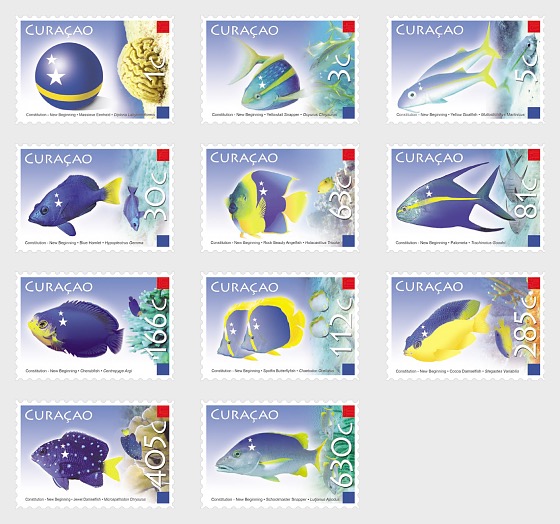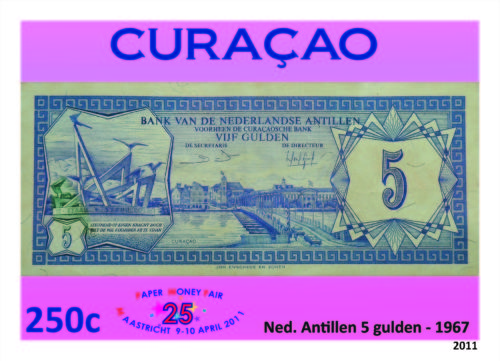Description
1 cent stamp: Curaçao-Massieve eenheid / Diploria Labyrinthiformis
The shape of the globe symbolizes one solid nation.
The colors blue, yellow and white represents the flag of Curacao.
Diploria labyrinthiformis is a reef building coral that, along with numerous other coral species, aids in creating a biodiversity-rich habitat for innumerable other coral reef animals.
3 cents stamp: Yellowtail Snapper / Ocyurus Chrysurus
The Yellowtail snapper is an abundant type of snapper found along the North American coast of the Atlantic Ocean. Their normal range is along Florida and down through the West Indies and Brazil. The original color of the Yellowtail snapper is grey with a yellow stripe which divides its body in two, likewise the flag of Curacao.
5 cents stamp: Yellow Goatfish / Mulloidichthys Martinicus
The Yellow Goatfish, also known as yellow saddle or gold saddle goatfish is a white to pale pink fish with a yellow stripe from the eye to the caudal peduncle. The goatfish species are noticeably colored and have the ability to change their coloration depending on their current activity.
30 cents stamp: Blue Hamlet / Hypoplectrus Gemma
The Blue Hamlet is a tropical fish having an iridescent blue color with thin dark borders along its tail. It is typically a shy species, preferring to hide among rock work.
63 cents stamp: Rock Beauty Angelfish / Halocanthus Tricolor
The young Rock Beauty Angelfish is completely yellow with a blue spot at the back site of his body. The body color of an adult Rock Beauty Angelfish however can be described as blue, while the facial region and the tail will keep the yellow color. The Rock Beauty Angelfish feeds primarily on sponges, but may also feed on small amounts of tunicates, jellyfish and corals. The Rock Beauty Angelfish is considered to be a difficult fish to keep in captivity.
81 cents stamp: Palometa Jack / Trachinotus Goodei
Palometa Jack is characterized by its deep silver body that is yellowish on the bottom, fat fleshy lips, and scattered black patches on its sides when mature. It is a quite attractive fish. All of its fins are yellow with the tips of the caudal fin being black. They have a distinguishing keel at the junction of the body and tail, which distinguish the Palometa from other members of the jack family.
166 cents stamp: Cherubfish / Centropyge Argi
The Cherubfish or pygmy angelfish (Centropyge argi) is a gentle omnivorous marine angelfish, with a metallic blue body and yellow to orange coloration in parts of the head only. It has a long-based dorsal fin and all of its fins are edged in bright blue. The Cherub fish Angelfish swim most of the time in pair in deep water and like to hide in the reefs.
112 cents stamp: Spotfin butterflyfish / Chaetodon Ocellatus
The Spotfin butterflyfish name is derived from the dark spot on the fish’s dorsal fin. This spot is considered a false eye which confuses predators. It has a black vertical stripe which runs down the side of the head and through the eye. The Spot fin butterfly fish use this black stripe to hide its real eyes. It has a small mouth at the end of a pointed snout. Most of its body is white with parts of the head and fins bright yellow. It has a small mouth at the end of a pointed snout and very sharp fin rays and these rays are extended when the fish feels threatened. Most of the time, the adults can be seen swimming in pairs while the younger ones are more likely to swim in small groups.
285 cents stamp: Cocoa Damselfish / Stegastes Variabilis
The cocoa damselfish or stegastes variabilis, is a damselfish of the family Pomacentridae found on coral and rocky reefs in the Caribbean Sea and neighboring areas in the Atlantic Ocean and Gulf of Mexico. When this fish is young its color is brilliant blue on his back with a lighter yellow color on its belly. As adult its back turned grayish brown and its belly becomes lighter colored. The Cocoa Juvinile Damsefish is fearless, not aggressive but it defends its territory. It mostly swims right towards the divers.
405 cents stamp: Jewel Damselfish / Microspathodon Chrysurus
Yellowtail Juvenile is a Damselfish from the Western Atlantic. It occasionally makes its way into the aquarium trade, where it is known as the Marine Jewelfish. It grows to a size of 21cm in length. When juvenile, it has brilliant blue spots that reflect light on a dark blue background. While it grows its tail turns yellow and its body becomes dark brown to black colored.
630 cents stamp: Schoolmaster Snapper / Lutjanus Apodus
The schoolmaster snapper or Lutjanus Apodus is common in southern Florida and the Caribbean. It has a robust slightly compressed body, with a pointed head. Its color varies from silvery to bronze. Fins and tails are yellow and the snout contains blue stripes. Schoolmaster Snapper lives in small groups in the shadow of the reefs. It keeps a short distance from the seafloor at depths between 10 and 90 feet.




